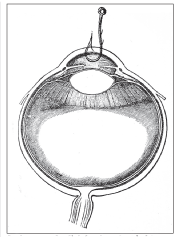 Summer, a time for relaxation and enjoying the warm weather, friends and family, offers the opportunity to engage in many outdoor activities. Fishing is one such hobby that attracts millions of aficionados both young and old.
Summer, a time for relaxation and enjoying the warm weather, friends and family, offers the opportunity to engage in many outdoor activities. Fishing is one such hobby that attracts millions of aficionados both young and old.
Typically, such pastimes are thought of merely as pleasant diversions, but it is important to recognize that there are inherent dangers associated with this recreational sport. When we consider fishing within the realm of ocular health and the potential for ocular injury, it can be downright dangerous.
A diagram of a fish hook embedded in the cornea. Note that the barbs along the shaft and bend can impart significantly greater damage if retrieved through the original wound.
Cruisin' for a Bruisin'

Ocular trauma from sports and recreational activities is estimated to result in more than 100,000 physician's office and ER visits each year.1 Moreover, these injuries often lead to visual impairment and account for more than 40,000 new cases of blindness annually.2
An array of traumatic entities has been documented in association with athletic activities; while most of these are the result of blunt-force, closed-globe injuries, penetrating injuries may also occur.3
Some of the more commonly encountered sequellae of sports-related trauma include orbital fracture, lid contusions, uveitis, hyphema, angle recession, retinal or vitreous hemorrhage, choroidal rupture and corneal abrasions.
Less commonly, you may see retinal detachment, optic nerve avulsion, corneal laceration and global perforation.3,4
The United States Eye Injury Registry (USEIR) is a federation of individual state eye injury registries. The organization collects and shares injury data via a common database. The USEIR documents serious eye injuries, those that are judged by the reporting physician to have a likelihood of resulting in permanent structural or functional damage to the eye and/or orbit.5 According to a report published in 2005 citing USEIR data, recreational fishing accounts for nearly 20% of all sports-related ocular trauma in the United States; only baseball produces a greater number of eye injuries.6
A Rod in the Eye?
Fishing-related ocular trauma can be quite varied in both etiology and clinical manifestations. Most injuries represent the inadvertent impact between the eye and the sinker (a weight tied to the line), the lure or bait, the hook, or the fishing pole itself. Ocular trauma usually occurs while casting the line or as a result of aggressive struggling to retrieve the line. The monofilament used in fishing is highly elastic, so substantial tension may cause it to snap toward the fisherman like a bungee cord--e.g., when freeing a line snagged underwater or on nearby foliage. Or, a fish may shed the hook while being retrieved from the water, causing the line to spring forward. Impact from a sinker, lure or pole usually yields blunt force, closed-globe injuries. Uveitis, hyphema, vitreous hemorrhage and traumatic cataract or subluxation are the most common clinical manifestations.6 Other findings may include iridodialysis, choroidal rupture and rhegmatogenous retinal detachment.6
Care of these patients requires a thorough evaluation, including dilated funduscopyeven if visual acuity appears to be unaffected. Traumatic uveitis and hyphema usually can be treated within an optometric setting. Address these conditions with a strong cycloplegic agent (we prefer 0.25% scopolamine for most cases) dosed b.i.d. to t.i.d., depending on severity. Topical corticosteroids are also crucial when managing traumatic conditions; these drugs serve to extinguish the inflammatory response and ameliorate the
associated pain. Choose an agent with good tissue penetration and efficacy, such as 1% prednisolone acetate or 0.5% loteprednol. Also, dose corticosteroids appropriately. We never prescribe steroids less than q.i.d., and typically, we will administer them every hour to two hours on the first day of therapy.
Vitreous hemorrhages should be followed closely to determine if retinal breaks or detachments are present, as these warrant prompt referral to a vitreoretinal specialist. Lenticular changes and subluxation may also necessitate surgical consultation, although these rarely require urgent care.
Hook, Line and Sinker
Penetrating injuries are a more serious complication of fishing-related trauma. Blunt force of sufficient magnitude can lead to global rupture, but open-globe injuries usually result from a fish hook penetrating the cornea or sclera.7,8 Penetrating injuries are a true ocular emergency, and care must be taken to maintain the integrity of the eye while expediting definitive surgical treatment to close the wound.
In fish hook injuries, it is important not to attempt to remove the hook outside the setting of an operating suite. Most commercial fish hooks have barbs, intended to keep a fish on the line, that will cause substantially greater damage when pulled back through the wound. Instead, the hook should be advanced to a point where the barbs are free of the ocular tissue, and then clipped.9
Fish hook injuries should be evaluated gingerly to lessen any risk of extrusion of intraocular contents. Rinse the eye gently with sterile saline to remove particulate and organic matter, and then tape the hook or lure in place to prevent further movement and damage. Shield the eye with a light dressing and arrange for immediate transport to an ophthalmic surgeon.
Fish hook injury to the eyelid has also been documented.9,10 These cases are not particularly sight-threatening, but they should still be treated similarly to a corneal or scleral fish hook injuryimmobilize the hook and refer the patient to a qualified surgeon (preferably an oculoplastic specialist) for attention.
Keep in mind that non-penetrating corneal injury is quite possible. Hooks, sinkers, lures, poles and even the fishing line itself can be responsible for corneal trauma, such as superficial abrasions and partial thickness lacerations.11 Such cases can typically be managed in the optometric setting, though the attending physician should remain vigilant against post-traumatic ocular infections. Due to the nature of the water and organic matter on the fishing gear, such atypical pathogens as fungi and Acanthamoeba must be considered.12
Given the vast potential for ocular damage and the popularity of this recreational activity, be sure to educate fishing enthusiasts about possible hazards, and encourage them to take steps to prevent injury.
First and foremost is the use of protective eyewear, be it spectacle correction or simply
Advise patients that the fisherman is not the only one at risk; so is everyone in the immediate vicinity. In one fishing study, nearly 25% of those injured were simply bystanders.6 The utmost caution should be exercised, with particular attention to children who might not understand the inherent dangers.
Finally, counsel fishing enthusiasts on the proper way to render first aid in cases of accidental injury. Emphasize that they should never attempt to remove an embedded fishhook because of the potential for greater damage to intraocular structures.
1. Napier SM, Baker RS, Sanford DG, Easterbrook M. Eye injuries in athletics and recreation. Surv Ophthalmol. 1996 Nov-Dec;41(3):229-44.
2. Kuhn F, Mester V, Morris R. Epidemiology and socioeconomic impact of ocular trauma. In: Alfaro DV III,
3. Rodriguez JO, Lavina AM, Agarwal A. Prevention and treatment of common eye injuries in sports. Am Fam Physician. 2003 Apr 1;67(7):1481-8.
4. Capo Filipe JA, Rocha-Sousa A, Falco-Reis F, Castro-Correia J. Modern sports eye injuries. Br J Ophthalmol. 2003 Nov;87(11):1336-9.
5.
6. Alfaro DV 3rd, Jablon EP, Rodriguez Fontal M, Villalba, et al. Fishing-related ocular trauma. Am J Ophthalmol. 2005 Mar;139(3):488-92.
7. Coden DJ. Ruptured globe caused by a fishing sinker. Arch Ophthalmol. 2002 Mar;120(3):407.
8. Malhotra R, Tappin M, Olver JM. Anglers fishing line sinker causing rupture of globe and medial wall fracture. Eye. 1999 Apr;13(Pt 2):260-2.
9. Srinivasan S, Macleod S. Fish hook injury to the eyelidan unusual case. Indian J Ophthalmol. 2001 Jun;49(2):115-6.
10. Kreis AJ. Fishing Down Under: case report and review of management of a fishhook injury of the eyelid. Clin Exp Optom. 2008 Sep;91(5):473-5.
11. Awan A, Scott JA. Corneal injury from a fishing line: a new mechanism. Eye. 2006 Sep;20(9):1084-6.
12. Meier PA, Mathers WD, Sutphin JE, et al. An epidemic of presumed Acanthamoeba keratitis that followed regional flooding. Results of a case-control investigation. Arch Ophthalmol. 1998 Aug;116(8):1090-4.
13. Classe JG. Sports related ocular trauma: a preventable epidemic. J Am Optom Assoc. 1996 Feb;67(2):66-7.

